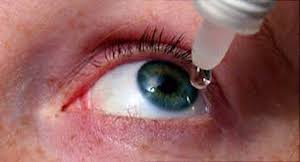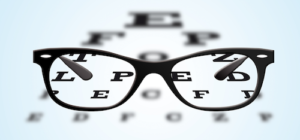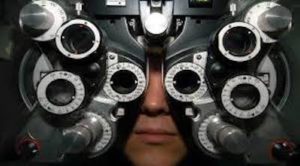Issues related to eyes and impaired vision

Editor’s Note: A special thanks to Jan Tennant, Ringwood, New Jersey for her efforts to provide a PRP-oriented tutorial on eyes and impaired vision. In so doing she set a standard for similar tutorials in other areas, e.g., feet and impaired mobility, hands and impaired dexterity, etc.
by Jan Tennant
Patients diagnosed with pityriasis rubra pilaris face a myriad of daily challenges to body, mind, and spirit. The following article focuses on our eyes and impairments to vision. A PRP patient can experience one or more of the following during their journey.
- Dry, gritty, irritated eyes with an inordinate amount of crusty gunk.
- Teary, blurry eyes.
- Tight skin on the face that pulls on our eyelids, making it hard to open our mouths wide or even eat.
- Flaking skin getting in the eyes, made worse by the loss of our protective eyelashes and eyebrows.
- Redness and sensitivity to light.
- Thickened and drooping lower eyelids making it hard to look in the mirror, or even see it.
That’s life with pityriasis rubra pilaris (PRP) for many of us. Fortunately, these interrelated symptoms usually improve with treatment and go away with remission. There are solutions! And there are answers to many of your questions, such as:
- Why are my eyes so dry and watery at the same time?
- What’s with the “sleep” in my eyes all day long?
- What is ectropion and what can I do about it?
- What’s the worst that can happen and what else should I be aware of?
- Who can help and how?
Why are my eyes dry and watery at the same time?
Tears are complex concoctions of chemicals with different roles to play. Tears form a film or coating that spreads out to cover the eye, nourishing it, protecting it, and keeping its special tissues, the cornea and conjunctiva (the clear tissue covering the white part of your eye and the inside of your eyelids), moist.
- Tears flush away the normal secretions the eye uses to maintain its health, such as the waxy substance that keeps our eyelashes soft, and the normal mucus that collects as we sleep.
- Tears also provide a protective barrier against the outside environment and germs, wash away dust and particles that get into the eye, and help minor injuries to heal. They are even necessary for proper vision, affecting refraction–how light enters the eye.
- Without normal tears, dry eyes are not just an inconvenience. They have a major impact on work and quality of life, and can lead to serious issues like damage to the cornea or the inability to drive a car.
With PRP, several factors combine to make our eyes particularly dry. We don’t have enough tears, but our eyes get watery in order to compensate for the dryness: with ineffective non-wetting tears. We have incomplete coverage of tears.
- Our tears may not spread out over the eye to coat it as they should, or the tears may evaporate too quickly due to drooping eyelids that keep our eyes from shutting properly or blinking normally (ectropion).
- Our tear ducts may become clogged and not drain properly. The conjunctiva is the lining of the inner eyelids and comes into direct contact with the whites of the eyes, called the sclera. The conjunctiva is a complex structure made of different types of epithelial skin. One of its functions that may be disrupted by PRP is to make a lubricating mucus that contributes to keeping the eyeball moist.
 Dry eyes are a common malady, and they are made worse by diseases like PRP and Sjögren’s syndrome, aging, vitamin A deficiency, smoking, air conditioning and other dry or dusty environments, hormonal changes, and staring at screens all day, forgetting to blink. Certain drugs contribute to dry eyes. Among the prime culprits are anti-histamines and allergy medications. Check your medication labels. Even isotretinoin (Accutane) is on the list of medications that can cause dry eyes.
Dry eyes are a common malady, and they are made worse by diseases like PRP and Sjögren’s syndrome, aging, vitamin A deficiency, smoking, air conditioning and other dry or dusty environments, hormonal changes, and staring at screens all day, forgetting to blink. Certain drugs contribute to dry eyes. Among the prime culprits are anti-histamines and allergy medications. Check your medication labels. Even isotretinoin (Accutane) is on the list of medications that can cause dry eyes.
- The first-line of treatment is to replace your own tears with artificial tears in the form of lubricating eye drops. These can be used as often as needed and are often necessary to get through a day comfortably. Realizing you don’t need hourly drops is another of those elusive benchmarks of success (healing milestones) in our frustrating disease.
- For very dry eyes, and for ectropion, where the eye remains partially open all night, gel eye ointments are used—made from white petrolatum (petroleum jelly), mineral oil, and similar lubricants. These over-the-counter preparations come in tiny tubes that you squeeze out and place inside your lower eyelid before bed. They make vision blurry, so they are often reserved only for nighttime use, but can be used at other times if needed.
- Use a humidifier.
- Avoid common risk factors, like smoke and dust and staring at screens for too long.
What’s with the “sleep” in my eyes all day long?
Here’s a word you’ve probably never heard before: Rheum (from the Greek word for flowing). It’s the technical term for the crud that builds up in our eyes when we sleep. In the healthy eye, rheum is a combination of mucus and other discharged dust and debris that accumulates throughout the day, and is continually washed away by tears. At night, when we aren’t blinking, it builds up into gunk or “sleep” in our eyes that we notice when we wake up. Certain infections or conditions can make this worse. If you’ve ever had “red eye” or conjunctivitis, you may have woken up with your eyes glued shut by thick rheum. If there is pus in this discharge, it can indicate infection—or extremely dry eyes. When we have PRP, the dryness of our eyes contributes to an excess of discharge at night. The additional effect of dry eyes and our poor quality tears results in a build-up of gunk and crusty, irritating grit all day long.
- Use care in cleaning the crust and gunk from your eyes, as too much rubbing of the very thin and sensitive skin can damage the underlying tissues, make ectropion worse, and cause irritation and redness.
- There are eyelid wipes made specifically to clean the build-up of discharge from the eyes. A very soft cloth with warm water may help. Talk to your medical doctor or eye doctor about the best way to clean your eyes.
- Eye drops (artificial tears) used during the day as needed can make the eyes feel less gritty and help keep large pieces of crust from forming.
What is ectropion and what can I do about it?

Ectropion (ek-TROH-pee-on), is another word for drooping eyelids. In PRP, it usually affects both lower lids. It is unsightly, uncomfortable, and thankfully it is usually temporary. However, it should be monitored by an eye doctor (a doctor of optometry or an ophthalmologist) to prevent serious damage to the eye from extreme dryness.
PRP can have dramatic effects on the lower eyelids of both eyes and the skin around the eyes. The normally thin lower eyelid may thicken. It begins to pull away from the eye. The bottom of the eyelid turns out and sags, exposing the red blood vessels. We open and shut our eyes by the action of muscles. The loss of our normal skin elasticity causes tightness around the eyes, pulling on the eyelids, and against the tiny muscles. The edema or swelling caused by erythroderma (the all-over redness common with PRP) also contributes to the pulling action. A more common cause of ectropion in one or both eyes is aging, when the muscles themselves become weakened. Ectropion has other causes, including reactions to topical lotions.
The eyelids protect the eyes from the environment and hold moisture in. The lower lid serves as a platform for the tears to pool into and it channels the flow of tears to the sensitive tissues of the eye. Our eyes need to close completely when we blink or sleep, and with ectropion, they are left open to the drying air all day and all night, leaving the cornea exposed and irritated. This dryness can lead to abrasions and ulcers. Severe eyelid ectropion can cause permanent scarring of the cornea, and loss of vision if not monitored and treated.
Ectropion seems to improve with time and treatment with the usual anti-inflammatory, systemic medications used for PRP (acitretin, methotrexate, and the biological drugs.) As inflammation goes down and other dermatologic symptoms improve, ectropion also improves.
- Lubricating eye drops and nighttime eye ointments help reduce the consequences of dry eyes caused by ectropion.
- Prescription dry eye medications can also help.
- Consultation with an ophthalmologist is critical in evaluating the effects of treatment and to discuss possible measures, such as surgical procedures.
What’s the worst that could happen and what else should I be aware of?

Our vision is such an important part of life that anything that impacts our eyes is serious.
We need our eyes to read, do our jobs, drive, see our loved ones’ faces, enjoy the beauty of the world around us…there are countless reasons to guard them from harm. Dry eyes and ectropion, and even the irritation caused by constant exposure to skin flakes, leave our eyes vulnerable to damage and serious infections, especially of the cornea. The inability to just blink away an irritant with ready tears is a problem for us. Immune-suppressant medications may make us more susceptible to infections. Some drugs prescribed for PRP have side effects that may affect vision. The cornea is the completely transparent covering of the iris (the colored part of the eye) and the pupil (its dark center). It helps focus light onto the lens of the eye, which sends visual information to the retina. It also helps protect the lens and retina from harmful ultraviolet (UV) light from the Sun. Severe dry eyes and the physical damage caused by foreign matter or scratches to this delicate structure can lead to abrasions, some of which can leave permanent scars that make vision hazy. Many instances of corneal abrasion are very minor and heal in a few days, but damage to the tissues can also create corneal ulcers that become infected, or cause the cornea to become inflamed (corneal keratitis). These are serious threats to the eyes if left untreated.
WARNING SIGNS FOR CORNEAL DAMAGE: Any excessive redness, sensitivity to light, headache, pain, or the feeling of something in the eye that won’t go away or a gritty feeling not caused by an obvious source should be evaluated.
Uncomfortable but less serious conditions can also occur. Without enough tears and moisture, the oil glands at the base of the eyelashes may become clogged, causing stys or a kind of eye inflammation called blepharitis (blef-uh-RYE-tis). Medications may contribute to eye problems beyond the common side effect of dry eyes. This short list of drugs that may be used by those with PRP is only for reference and you should refer to package inserts and your prescriber if you have concerns.
- Prednisone and corticosteroids can contribute to the development of cataracts.
- Cyclosporine, which can be prescribed for the treatment of PRP, has some rare visual side effects that go away when the medication is stopped. Patients can experience vision loss in both eyes that has nothing to do with the eyes, but involves an effect of the medication on the area at the back of the brain that processes vision.
- Hydroxychloroquine (Plaquenil), which is used to treat auto-immune diseases and is occasionally prescribed for PRP, is well-known to cause irreversible retinal damage, but not often in the doses usually prescribed. Rheumatologists and eye doctors know to screen patients’ eyes on a regular basis.
Other ways for PRP patients and caregivers to protect eyes and vision include:
✻ Read the labels on your medications and discuss issues with your prescriber or the pharmacist.
✻ Use creams or ointments on your face that help minimize shedding of skin flakes.
✻ Protect your eyes from excess sun and artificial UV light, dust, and debris.
✻ You might want to invest in extra-large sunglasses and even eye glasses, to protect dry eyes from the elements.
✻ Ask your eye doctor about any concerns you have about your eyes. He or she is uniquely qualified to diagnose, treat, and monitor minor to severe issues with your eyes.
Who can help and how?
 First, remember: Your dermatologist is an expert on the skin, but if you are having any issues with your eyes, and especially if you have excessively dry eyes or ectropion, you need to consult an expert on the eyes: a Doctor of Optometry (O.D.), who can diagnose and treat most eye disorders or an Ophthalmologist, who can go further, by doing surgery and may have a specialty in particular disorders. If you start your consultation with an O.D. (usually the same person who measures you for corrective lenses), they will refer you to an ophthalmologist for severe problems. What will your eye doctor do? Eye doctors have much more than the machines used for measuring you for corrective lenses. They have special equipment to examine your eyes, such as the slit lamp. The slit lamp focuses a high-intensity light into the eye and allows the physician to examine the eyelids, sclera, conjunctiva, iris, lens, and cornea. A separate lens is used to examine the retina. With these tools, they can see changes and monitor problems that no other doctor will be able to see with a simple flashlight or lamp.
First, remember: Your dermatologist is an expert on the skin, but if you are having any issues with your eyes, and especially if you have excessively dry eyes or ectropion, you need to consult an expert on the eyes: a Doctor of Optometry (O.D.), who can diagnose and treat most eye disorders or an Ophthalmologist, who can go further, by doing surgery and may have a specialty in particular disorders. If you start your consultation with an O.D. (usually the same person who measures you for corrective lenses), they will refer you to an ophthalmologist for severe problems. What will your eye doctor do? Eye doctors have much more than the machines used for measuring you for corrective lenses. They have special equipment to examine your eyes, such as the slit lamp. The slit lamp focuses a high-intensity light into the eye and allows the physician to examine the eyelids, sclera, conjunctiva, iris, lens, and cornea. A separate lens is used to examine the retina. With these tools, they can see changes and monitor problems that no other doctor will be able to see with a simple flashlight or lamp.
✻ Your eye doctor can see if you have scratches or other damage to your cornea. Management of your dry eyes and ectropion will depend on whether you already have damage to the cornea and the conjunctiva.
- If you have ectropion, your eye doctor can see how well your eyes are closing, tell you how to minimize damage, monitor the effectiveness of treatment, and discuss other options such as surgical repair if no other treatment is helping.
- Eye doctors use special dyes to see how well and how quickly your tears are spreading out to cover the surface of the eyes and how fast the tears are evaporating or breaking up. This will help the doctor advise you on the best type of eye drops to use, and yours may prescribe medicated drops, such as antibiotic eye drops, anti-inflammatory/steroid eye drops, and prescription dry eye medications, like Restasis.
- If necessary, the doctor can perform procedures to keep the tear ducts clear and functional—or they can block them. In order to increase the amount of tears the eye doctor may use punctal plugs. In each eye, there are two tiny openings (puncta) that drain tears into the tear ducts, and from there, some of the tears end up in the nose. An eye doctor can use methods to close these tear ducts, partially or completely, in one or both eyes. This results in fewer tears escaping into the nasal passages and more remain in the eyes. This procedure is reserved for dry eyes that are not responsive to other treatments.
- Your eye doctor will help you assess when you may resume wearing contact lenses, which are not recommended if you have severely dry eyes or ectropion.
ABOUT THE AUTHOR Jan Tennant is a Contributor to the PRP Survival Survival Guide. As a PRP patient, the first symptoms of PRP appeared October 2016 at the age of 64. She lives in Ringwood, New Jersey with her husband Malcolm
And for those with an appetite for more…
✻ References used in the preparation of this article
✻ Dry Eyes (Mayo Clinic)
✻ How to select eyedrops for dry eyes (Mayo Clinic)

